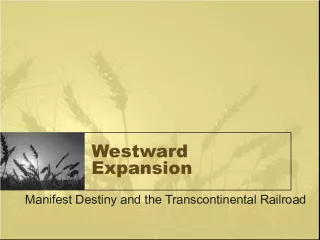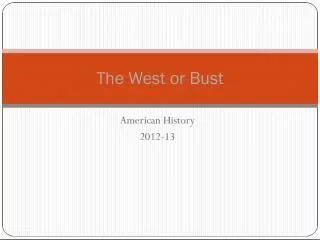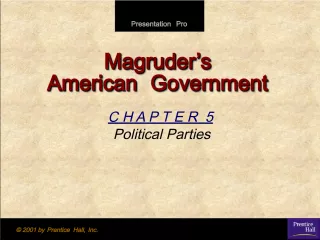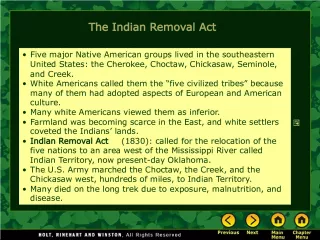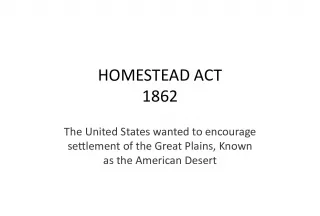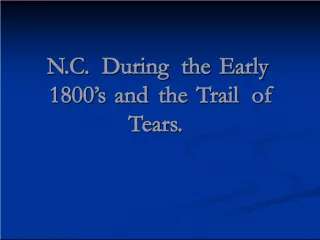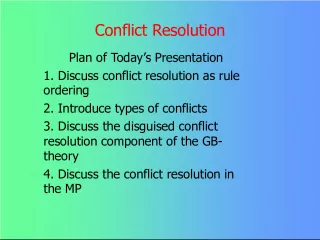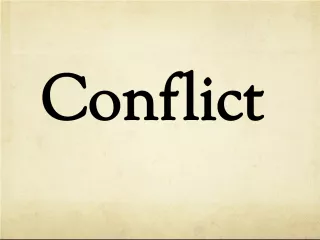The Fight for the West: The American Settler-Native American Conflict


The Fight for the West explores the historical conflict between white American settlers and Native Americans as the United States expanded westward. The stage was set for tension
- Uploaded on | 2 Views
-
 hannaturner
hannaturner
About The Fight for the West: The American Settler-Native American Conflict
PowerPoint presentation about 'The Fight for the West: The American Settler-Native American Conflict'. This presentation describes the topic on The Fight for the West explores the historical conflict between white American settlers and Native Americans as the United States expanded westward. The stage was set for tension. The key topics included in this slideshow are . Download this presentation absolutely free.
Presentation Transcript
Slide1The Fight for the WestThe Main Idea Native Americans fought the movement of settlers westward, but the U.S. military and the persistence of American settlers proved too strong to resist. Reading Focus • How was the stage set for conflict between white settlers and Native Americans in the West? • What were the Indian Wars and their consequences? • How did Native American resistance to white settlement end? • What was life like on the Indian Reservation?
Slide2Stage Set for Conflict• Culture of the Plains Indians – Buffalo provided food, clothing, and shelter for the nomadic lifestyle of the Indians. They did not believe land should be bought and sold, and white farmers felt it should be divided. • Government policy – Instead of continuing to move the Indians westward, the government changed its policy. Indian land was seized, and they were forced onto reservations. • Destruction of the buffalo – The buffalo-centered way of life was threatened, with vast herds driven to extinction by reduced grazing lands and hunting for sport and profit.
Slide3The Indian WarsAfter the massacre, Cheyenne and Sioux stepped up their raids. In return for closing a sacred trail, the Sioux agreed to live on a reservation. Other nations signed the Medicine Lodge Treaty and were moved to reservation lands in western Oklahoma. Sand Creek Massacre Army troops attacked and massacred surrendering Cheyenne. Congressional investigators condemned the Army actions, but no one was punished in the Sand Creek Massacre . Treaties George Armstrong Custer led his troops in headlong battle against Sitting Bull and lost. The Battle of the Little Bighorn was a temporary victory for the Sioux. The U.S. government was determined to put down the threat to settlers. The Battle of the Little Bighorn
Slide4The Indian WarsThe Ghost Dance was a religious movement that inspired hope among suffering Native Americans. Newspapers began suggesting that this signaled a planned uprising. The military killed Sitting Bull while attempting to arrest him in a skirmish. Palo Duro Canyon The Battle of Palo Duro Canyon ended the Indian Wars on the southern Plains. With their ponies killed and food stores destroyed, surviving Comanches moved onto the reservation. The Ghost Dance The Wounded Knee Massacre occurred the day after the surrender. Shooting began after a gun went off, and the fleeing Sioux were massacred. This action marked the end of the bloody conflict between the army and the Plains Indians. Wounded Knee
Slide6Resistance Ends in the WestResistance in the Northwest • The government took back nine-tenths of the Nez Percé land when gold miners and settlers came into the area. • Fourteen years later they were ordered to abandon the last bit of that land to move into Idaho. • Chief Joseph tried to take his people into Canada, but the army forced their surrender less than forty miles from the Canadian border. • Chief Joseph and many others were eventually sent to northern Washington. Resistance in the Southwest • The Apache people were moved onto a reservation near the Gila River in Arizona. • Soldiers forcefully stopped a religious gathering there, and Geronimo and others fled the reservation. • They raided settlements along the Arizona-Mexico border for years before finally being captured in 1886. • Geronimo and his followers were sent to Florida as prisoners of war. His surrender marked the end of armed resistance in the area.
Slide7Life on the ReservationThe government wanted control over all the western territories and wanted Indians to live like white Americans. The Bureau of Indian Affairs began to erase the Indian culture through a program of Americanization . Indian students could speak only English and could not wear their traditional clothing. They learned to live like Americans. The Dawes Act of 1887 broke up many reservations and turned Native Americans into individual property owners. Ownership was designed to transform their relationship to the land. The Indians received less productive land, and few had the money to start farms. Most of the land given to the Indians was unsuitable for farming.
Slide8Video• Click Here
Slide11The package the Indian isholding is labeled “starvation rations.” Each bag hanging from the agent is labeled “profits.”

